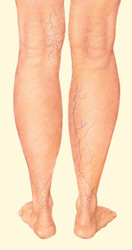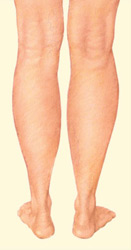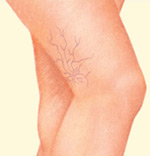Enhancing your appearance with spider vein treatment
 IIn some women, spider veins – those small clusters of red, blue, or purple veins that appear on the thighs, calves, and ankles – become noticeable at ayoung age. For others, the veins may not become obvious until much later. A number of factors may contribute to the development of spider veins in the legs, including:
IIn some women, spider veins – those small clusters of red, blue, or purple veins that appear on the thighs, calves, and ankles – become noticeable at ayoung age. For others, the veins may not become obvious until much later. A number of factors may contribute to the development of spider veins in the legs, including:
- Heredity
- Hormonal shifts
- Occupations or activities that require prolonged sitting or standing
- Pregnancy
- Weight fluctuation
There are effective, safe and relatively painless methods available for reducing spider veins. Spider vein treatment is a good option if you:
- Are bothered by spider veins anywhere on your body
- Are committed to following your plastic surgeon’s prescribed course of treatment
- Have a positive outlook and realistic goals for your spider vein treatment
Is it right for me?
Spider vein treatment is a highly individualized procedure and you should do it for yourself, not to fulfill someone else’s desires or to try to fit any sort of ideal image. Spider vein treatment can be performed on people of any age and is a good option for you if:
- You are bothered by spider veins anywhere on your body
- You have a positive outlook and realistic goals for your spider vein treatment
- You are committed to following your plastic surgeon’s prescribed course of treatment
 The success and safety of your procedure depends very much on your complete candidness during your consultation. You’ll be asked a number of questions about your health, desires and lifestyle.
The success and safety of your procedure depends very much on your complete candidness during your consultation. You’ll be asked a number of questions about your health, desires and lifestyle.
Be prepared to discuss:
- Why you want the procedure, your expectations and desired outcome
- Any problems you may have had in the area to be treated, such as pain or previous injuries
- Any surgical procedures that have been performed near the area to be treated, including any previous vein treatments
- Medical conditions, family history, drug allergies, and medical treatments
- Use of current medications, vitamins, herbal supplements, alcohol, tobacco and drugs
Your surgeon may also:
- Evaluate your general health status and any pre-existing health conditions or risk factors
- Examine your veins in detail
- Discuss your options and recommend a course of treatment
- Discuss likely outcomes of spider vein treatment and any risks or potential complications
If leg veins are the problem, your surgeon may examine you for signs of more serious “deep vein” problems, as well as for larger, varicose veins. These conditions are often identified by swelling, sores, or skin changes at the ankle. If more serious vascular problems are identified, your surgeon may refer you to a different specialist for further evaluation and possible treatment.
 Prior to your procedure, you may be asked to:
Prior to your procedure, you may be asked to:
- Get lab testing or a medical evaluation
- Take certain medications or adjust your current medications
- Stop smoking
- Avoid taking aspirin and certain anti-inflammatory drugs and herbal supplements as they can increase bleeding
Special instructions you receive will cover:
- What to do on the day of treatment
- Care and follow-up
Spider vein treatment requires no anesthesia and is usually performed in an outpatient setting. More than one treatment session may be required to obtain optimal results.
Sclerotherapy requires no anesthesia and is usually performed in an outpatient setting. Two or more sessions, each lasting less than an hour, are usually required to obtain optimal results.
Step 1 – The treatment
The common method of treating spider veins in the legs and ankles is called sclerotherapy. During this treatment, a sclerosing solution is injected into the affected veins. The injection irritates the inside of the vein, and over time the vein will collapse and fade from view. If you have multiple spider veins, the treatment will require multiple injections to collapse all the veins.
Bright light and magnification may be used to ensure maximum precision while injecting the sclerosing solution.


Spider veins may also be treated with a laser. In this method, an intense beam of light is directed at the spider vein, which obliterates it through the skin. More than one laser session may be needed to obtain the desired results. Sometimes, laser therapy is used in combination with sclerotherapy.


Step 2 – After treatment
After treatment, the area may be dressed with compressive tape or stockings, or an elastic Ace wrap for a period of time. The veined area often looks a bit bruised initially, and the color slowly fades over the course of a few weeks. Some people can have a bit of brownish discoloration (hyperpigmentation) occur to the area during the healing process. This hyperpigmentation fades as well, but may take months.
The decision to have spider vein treatment is extremely personal. You will have to decide if the benefits will achieve your goals and if the risks and potential complications are acceptable. You will be asked to sign consent forms to ensure that you fully understand the procedure and any risks.
 The decision to have spider vein treatment is extremely personal and you’ll have to decide if the benefits will achieve your goals and if the risks and potential complications are acceptable.
The decision to have spider vein treatment is extremely personal and you’ll have to decide if the benefits will achieve your goals and if the risks and potential complications are acceptable.
Your plastic surgeon and/or staff will explain in detail the risks associated with surgery. You will be asked to sign consent forms to ensure that you fully understand the procedure you will undergo, the alternatives and the most likely risks and potential complications.
Some of the risks include:
- Swelling and bruising
- Change in skin sensation
- Infection
- Hyperpigmentation
- Ulceration
- Scarring
- Persistent pain leeding (hematoma)
Be sure to ask questions: It’s very important to ask your plastic surgeon questions about your procedure. It’s natural to feel some anxiety, whether it’s excitement for your anticipated new look or a bit of preoperative stress. Don’t be shy about discussing these feelings with your plastic surgeon.
Where will my procedure be performed?
Spider vein treatment is usually performed in your plastic surgeon’s office.
After your treatment, you may be instructed to wear support hose to help your legs heal. The treated sites will appear bruised and you may feel some cramping in your legs for the first day or two after treatment. This discomfort is temporary and usually doesn’t require prescription medication.
Although every patient heals at a different rate, most are back to normal activities quickly. You will be given specific instructions that may
include how to care for your legs following treatment, medications to apply or take orally to aid healing and reduce the risk of infection, and when to follow-up with your plastic surgeon.
When you go home
Should any complications occur, notify your plastic surgeon who will determine if any additional treatment is needed.
Be careful
Following your physician’s instructions is key to the success of your treatment. It is important that the injection sites are not subjected to excessive force, abrasion, or motion during the time of healing. Your doctor will give you specific instructions on how to care for yourself.
Every patient heals at a different rate. However, you can expect that your recovery will follow this general time line:
Within the first week
- You may be instructed to wear support stockings for three to six weeks
- You should avoid squatting, heavy lifting and running
- The tape, cotton balls or any other dressings (if used) will be removed from the treated areas when recommended by the plastic surgeon
- The treated sites will appear bruised
- You will be discouraged from sitting or standing in one place for more than an hour or two
Within one month
- The bruises at the treated sites will diminish
- You will begin to feel more comfortable wearing leg-baring fashions
- You can resume most exercise
- One month after the first treatment, spider veins are distinctly lighter, yet still somewhat visible
- You will be discouraged from sitting or standing in one place for more than an hour or two
The practice of medicine and surgery is not an exact science. Although good results are expected, there is no guarantee. Be sure to discuss with your surgeon the results expected in your case, as well as the cost involved.
 After two months, your veins treatment should have completed its healing. At this point, you and your plastic surgeon will decide if any additional treatment is necessary.
After two months, your veins treatment should have completed its healing. At this point, you and your plastic surgeon will decide if any additional treatment is necessary.
After each treatment, you will notice improvement of your skin’s appearance. However, it is important to realize that new spider veins may surface in the future. As time passes, you may want to consider further treatment to take care of any new veins that may emerge.
 Cost is always a consideration in elective treatment. Prices for spider vein procedures can vary widely. A surgeon’s cost for may vary based on his or her experience, the type of procedure used, as well as geographic location. Many plastic surgeons offer patient financing plans, so be sure to ask.
Cost is always a consideration in elective treatment. Prices for spider vein procedures can vary widely. A surgeon’s cost for may vary based on his or her experience, the type of procedure used, as well as geographic location. Many plastic surgeons offer patient financing plans, so be sure to ask.
Cost may include:
- Surgeon’s fee
- Surgical facility costs
- Prescriptions for medication
- Post-treatment garments, and
- Medical tests
Most health insurance plans will not cover spider vein treatment, related complications or another procedure to revise the appearance of your legs. You must carefully review your health insurance policy.
Your satisfaction involves more than a fee
When choosing a plastic surgeon for spider vein treatment, remember that the surgeon’s experience and your comfort with him or her are just as important as the final cost of the procedure.
- Arborizing veins: Veins that resemble tiny, branch-like shapes in a cartwheel pattern, often seen on the outer thigh.
- Hyfrecation: Spider vein treatment in which the vessels are cauterized.
- Laser therapy: An intense beam of light passed over the leg to eliminate spider veins.
- Laser treatment: An intense beam of light directed at the spider vein, which obliterates it through the skin.
- Reticular veins: Larger, darker leg veins that tend to bulge slightly, but are not severe enough to require surgical treatment.
- Sclerotherapy: Sclerosing solution injected into a vein, causing it to collapse and fade from view.
- Simple linear veins: Veins which appear as thin, separate lines, and are commonly seen on the inner knee or on the face.
- Spider-shaped veins: A group of veins radiating outward from a dark central point.
- Spider veins: Small clusters of red, blue or purple veins that appear in the skin on the thighs, calves and ankles.
- Support hose: Special stockings that compress your legs, typically used for varicose veins and post-surgical conditions.
- Ultrasound: A device that uses high-frequency sound waves to create images of organs and systems within the body.
- Varicose veins: Abnormally swollen or dilated veins.
- Venous system: Veins.
Use this checklist as a guide during your consultation
- Are you certified by the American Board of Plastic Surgery?
- Were you trained specifically in the field of plastic surgery?
- How many years of plastic surgery training have you had?
- How many procedures of this type have you performed?
- Am I a good candidate for this procedure?
- Where and how will you perform my procedure?
- How long of a recovery period can I expect, and what kind of help will I need during my recovery?
- What are the risks and complications associated with my procedure?
- How are complications handled?
- What are my options if I am dissatisfied with the cosmetic outcome of my spider vein treatment?
- Do you have before-and-after photos I can look at for each procedure and what results are reasonable for me?
Plastic surgery involves many choices. The first and most important is selecting a surgeon you can trust.
Choosing an ASPS Member Surgeon ensures that you have selected a physician who:
- Has completed at least five years of surgical training with a minimum of two years in plastic surgery.
- Is trained and experienced in all plastic surgery procedures, including breast, body, face and reconstruction.
- Operates only in accredited medical facilities
- Adheres to a strict code of ethics.
- Fulfills continuing medical education requirements, including standards and innovations in patient safety.
- Is board certified by The American Board of Plastic Surgery or in Canada by the Royal College of Physicians and Surgeons of Canada®.
ASPS Member Surgeons are your partners in cosmetic and reconstructive plastic surgery.
Look for the ASPS Member Surgeon logo.

 3510 N. Ridge Rd, Suite 100
3510 N. Ridge Rd, Suite 100